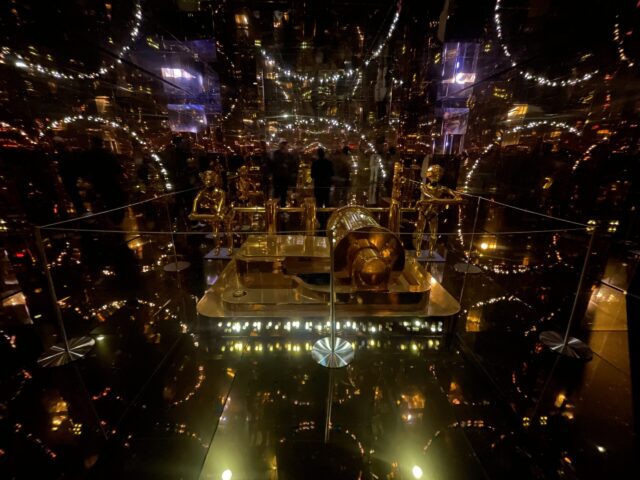
“Music Box” is one of fifteen multimedia installations at Mercer Labs inspired by Roy Nachum’s nightmares (photo by twi-ny/mdr)
DARK MATTER: NIGHTMARE BEFORE MIDNIGHT
Mercer Labs Museum of Art and Technology
21 Dey St. at Cortland St.
Through October 30, $46-$52
mercerlabs.com
roynachum.com
dark matter online slideshowthe dragon
“Everyone knows two things about dreams, namely 1) other people’s dreams are dull and 2) they’re going to tell you about them anyway. And as they burble on,” Black Mirror co-showrunner Charlie Brooker wrote in the Guardian in 2013, “it’s hard not to fall asleep and start dreaming yourself.”
Multidisciplinary experimental artist Roy Nachum, who was born in Jerusalem, lives in New York City, and works in New York and Italy, doesn’t shy away from sharing his dreams in the multimedia exhibition “Dark Matter: Nightmare Before Midnight,” continuing through October 30 at Mercer Labs Museum of Art and Technology, the downtown institution he cofounded with Michael Cayre that opened in February. The immersive, interactive exhibit features fifteen rooms, each containing audiovisual stimuli with images that range from fun and fancy-free to strange and horrific. In a statement, Nachum elucidates, “‘Dark Matter’ examines the role of darkness in art history. Revealing how the subconscious uncertainty and the unknown has shaped artistic movements and expressed cultural anxieties across time. The exhibition is a mirror to our fears and fascinations with the unknown.”
Visitors begin their journey with “The Window,” a circle on the ceiling that morphs into a trompe l’oeil dome opening into a swirl of cool shapes and colors, set to grand music, that practically sucks you in like an alien ship beaming you up. In “The Cave,” short films of a mysterious monkey appear amid a landscape of pink flowers (and a bar where you can purchase specially concocted nonalcoholic drinks). In “Archetype,” a robotic machine endlessly rakes sand, reminiscent of Sun Yuan and Peng Yu’s Can’t Help Myself but more meditative than dystopian. In “The Game,” people can play chess with large-scale creature-pieces on a board that emits screams and other loud noises as you walk across the squares. In “The Map,” you can sit on central cushions or on one of several swings as a barrage of sound and images pour over the walls, floor, and ceiling.
“Infinite” might make you dizzy with its twisting, mirrored images of snakes and innards. “Freedom” is a peaceful respite. “The Dragon” is like an endless zone of swirling shapes and colors. “Music Box” is a giant gold music box in a mirrored room, the central figure wearing a crown like those that form a tower in Nachum’s 2016 Kings statue that reigns in front of a Tribeca condo. “Ecosystem” unfurls at your feet, depicting a cinematic chase and, well, I’m not quite sure what to call some of the other fantastical adventures.
In “Ball Pond,” visitors can slide into a pond of little balls. “Pneumatic Transmission” is a futuristic mirrored room of interweaving tubes that could be a scene from Stanley Kubrick’s 2001: A Space Odyssey. “Drawing Station” gives everyone the chance to see their own sketch appear on a projection of a spinning skull. (Around the corner are a few kiosks where you can create images using your finger on a screen, but beware the hellish monster.) And in “4DSound,” Nachum’s personal favorite, a dreamlike enclsure appearing to be floating offers a soothing soundscape; visitors are encouraged to lie down on the floor and let it all envelop them.
In 2015, on BBC Radio 4’s Four Thought, interdisciplinary historian Dr. Shane McCorristine said, “The ubiquity of the Freudian model of dreams as repressed wish-fulfilments . . . played a key role in making people think that dreams were internal, private matters, and not the kind of thing you discussed with others.” Nachum must not be a Freudian.
While “Dark Matter” might be Instagram-friendly in the way that immersive exhibitions of beloved artists (van Gogh, Klimt, Monet) are, it is a deeper experience. Don’t just keep your phone out taking pictures and video but try to feel each installation. Like your own dreams, some will titillate you, some frustrate you, some bewilder you, some bore you, and others delight you. You might not want to sit down with Nachum and listen to him tell you his dreams and nightmares and try to interpret them as repressed wish-fulfilments — he can’t sleep very well — but for an hour or so, it’s worth walking through the wild and unpredictable internal scenarios that haunt him night after night and now are public, for all of us to encounter.
[Mark Rifkin is a Brooklyn-born, Manhattan-based writer and editor; you can follow him on Substack here.]